
A trow was a type of cargo boat found in the past on the rivers Severn and Wye in Great Britain and used to transport goods.

A trow was a type of cargo boat found in the past on the rivers Severn and Wye in Great Britain and used to transport goods.
The mast could be taken down so that the trow could go under bridges, such as the bridge at Worcester and the many bridges up and downstream. The mast was stepped in a three sided frame open at the rear but closed with an iron pin or rope lashing. From the top of the mast a forestay ran down to the bow winch. To lower the mast the pin was removed and the winch slackened off to let the mast fall towards the stern. The reverse operation pulled the mast up.
Despite their flat-bottomed hull form which made volume available for their load and permitted drying out on muddy banks in the tidal area where they operated, Trows were seaworthy. For example, with an added keel the Droitwich Trow Hastings is recorded as taking 90 tons of salt from Droitwich to France across the English Channel. [1] The flat-bottomed trows sailed on the sea by hauling a 20-foot (6.1 m) log of wood under the hull strapped with chains to act as a temporary keel, to limit leeway (the hull sliding sideways under lateral sail pressure on their fore-and-aft rig). [2]

There are two traditional types of Severn Trow. Prior to the 1840s the River Severn was tidal up to Worcester. The trows that were used on the tidal portion of the River were called Downstream Trows whilst those that sailed north of Worcester were called Upstream Trows and were smaller. During the summer the flow of water was often very low and so the trows were pulled over the resultant shallows. A rope was attached to the mast and the men who pulled the boats were called bow hauliers. The men would enter into a contract with the captain of the trow in the many pubs along the Severn riverbanks, and there was a right of way along the bankside. A document originally published in 1940 about such vessels states that the term trow is "believed to have been derived from the same root as the word 'trough'". [3]
A Trow called Joan was owned by a timber merchant called Oliver Luff. He used her to bring timber from Tintern, Monmouthshire into 'The Back' now called 'Welsh Back' in Bristol's Floating Harbour, where he owned two timber yards. A pub, the Llandoger Trow is situated in Bristol.
A replica Wye trow, named Hereford Bull, was constructed in 2012 to participate in the Thames Diamond Jubilee Pageant. [4] [5]

The last complete Severn trow still in existence, the Downstream Trow Spry, went into operation on 25 October 1894 and worked in the Bristol Channel, primarily moving limestone from quarries in the Chepstow area to the Cardiff, Wales area in her early years. A reliable source states that "she was originally sloop rigged, with a jib, staysail, topsail and gaff main," as well as a mast believed to have been fixed. Her condition deteriorated over the years, becoming derelict. The Spry was rebuilt [6] with many new components; the effort began in 1983 and was not fully completed until 1992. She is currently on display at the Blists Hill site of the Ironbridge Gorge Museums in a dry location (not on water). [7]
A smaller (18 feet (5.5 m) max) boat called a 'Trow' is peculiar to the Fleet lagoon in Dorset. It is used primarily for the transport of mackerel caught by seine net fishing crews off Chesil Beach. Once caught they are boxed and transported across to the mainland by these flat-bottomed boats. Unlike the River Severn version the Fleet variant is only ever towed, rowed or punted and has no mast or sail. [8]
Trow may be pronounced as trō (rhyming with "crow") or as trou (rhyming with "cow"). [9] The former pronunciation was the usual one throughout Worcestershire, Shropshire and Dorset. While the latter exists regionally, dictionaries often give only the former pronunciation.

Barge often refers to a flat-bottomed inland waterway vessel which does not have its own means of mechanical propulsion. The first modern barges were pulled by tugs, but on inland waterways, most are pushed by pusher boats, or other vessels. The term barge has a rich history, and therefore there are many other types of barges.

The River Severn, at 220 miles (354 km) long, is the longest river in Great Britain. It is also the river with the most voluminous flow of water by far in all of England and Wales, with an average flow rate of 107 m3/s (3,800 cu ft/s) at Apperley, Gloucestershire. It rises in the Cambrian Mountains in mid Wales, at an altitude of 2,001 feet (610 m), on the Plynlimon massif, which lies close to the Ceredigion/Powys border near Llanidloes. The river then flows through Shropshire, Worcestershire and Gloucestershire. The county towns of Shrewsbury, Worcester and Gloucester lie on its course.

The River Wye is the fourth-longest river in the UK, stretching some 250 kilometres from its source on Plynlimon in mid Wales to the Severn Estuary. For much of its length the river forms part of the border between England and Wales. The Wye Valley is designated an Area of Outstanding Natural Beauty. The Wye is important for nature conservation and recreation, but is affected by pollution.

The River Teme rises in Mid Wales, south of Newtown, and flows southeast roughly forming the border between England and Wales for several miles through Knighton before entering England in the vicinity of Bucknell and continuing east to Ludlow in Shropshire. From there, it flows to the north of Tenbury Wells on the Shropshire/Worcestershire border on its way to join the River Severn south of Worcester. The whole of the River Teme was designated as an SSSI by English Nature in 1996.

Boat building is the design and construction of boats — and their on-board systems. This includes at minimum the construction of a hull, with any necessary propulsion, mechanical, navigation, safety and other service systems as the craft requires.

A cutter is a name for various types of watercraft. It can apply to the rig of a sailing vessel, to a governmental enforcement agency vessel, to a type of ship's boat which can be used under sail or oars, or, historically, to a type of fast-sailing vessel introduced in the 18th century, some of which were used as small warships.
This glossary of nautical terms is an alphabetical listing of terms and expressions connected with ships, shipping, seamanship and navigation on water. Some remain current, while many date from the 17th to 19th centuries. The word nautical derives from the Latin nauticus, from Greek nautikos, from nautēs: "sailor", from naus: "ship".

The Droitwich Canal is a synthesis of two canals in Worcestershire, England; the Droitwich Barge Canal and the Droitwich Junction Canal. The Barge Canal is a broad canal which opened in 1771 linking Droitwich Spa to the River Severn at Hawford Bottom Lock, Claines. The Droitwich Junction Canal is a narrow canal, opened in 1854, which linked Droitwich to the Worcester and Birmingham Canal. Both were built to carry salt, and were abandoned in 1939. They have been the subject of a restoration plan since 1973, and the Barge Canal was officially reopened in 2010, while the Junction Canal reopened in July 2011. Following the opening of the canal, ownership transferred to the newly created Canal and River Trust
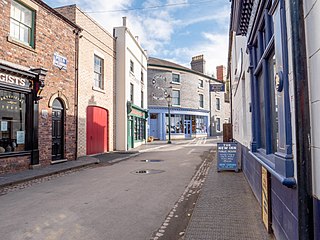
Blists Hill Victorian Town is an open-air museum built on a former industrial complex located in the Madeley area of Telford, Shropshire, England. The museum attempts to recreate the sights, sounds and smells of a Victorian Shropshire town in the late 19th and early 20th centuries. It is one of ten museums operated by the Ironbridge Gorge Museum Trust.

The Hay Inclined Plane is a canal inclined plane in the Ironbridge Gorge in Shropshire, with a height of 207 feet (63 m). It was located at the end of the Shropshire Canal, part of a network of canals that linked the industrial region of east Shropshire with the River Severn. The inclined plane was in operation from 1793 to 1894. It can be visited as part of the Blists Hill Victorian Town and is also a waypoint on the South Telford Heritage Trail.

The Llandoger Trow is a historic public house in Bristol, south-west England. Dating from 1664, it is on King Street, between Welsh Back and Queen Charlotte Street, near the old city centre docks. Named by a sailor who owned the pub after Llandogo in Wales which built trows, the building was damaged in World War II, but remained in sufficiently good condition to be designated Grade II* listed building status in 1959. The pub is said to have inspired Robert Louis Stevenson to write of the Admiral Benbow Inn in Treasure Island and Daniel Defoe supposedly met Alexander Selkirk there, his inspiration for Robinson Crusoe. The pub is also supposedly haunted, with up to 15 ghosts and one little green ghoul, the best known being a small child whose footsteps can be heard on the top floor.

A Thames sailing barge is a type of commercial sailing boat once common on the River Thames in London. The flat-bottomed barges, with a shallow draught and leeboards, were perfectly adapted to the Thames Estuary, with its shallow waters and narrow tributary rivers. The larger barges were seaworthy vessels, and were the largest sailing vessel to be handled by just two men. The average size was about 120 tons and they carried 4,200 square feet (390 m2) of canvas sail in six working sails. The mainsail was loose-footed and set up with a sprit, and was brailed to the mast when not needed. It is sheeted to a horse, as is the foresail; they require no attention when tacking. The foresail is often held back by the mate to help the vessel come about more swiftly.

Coalport is a village in Shropshire, England. It is located on the River Severn in the Ironbridge Gorge, a mile downstream of Ironbridge. It lies predominantly on the north bank of the river; on the other side is Jackfield. It forms part of the civil parish of the Gorge and is the south-eastern corner of the borough of Telford and Wrekin.
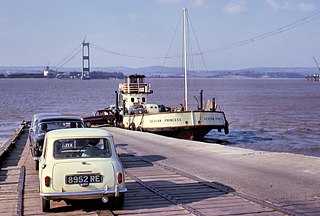
Aust Ferry or Beachley Ferry was a ferry service that operated across the River Severn between Aust and Beachley, both in Gloucestershire, England. Before the Severn Bridge opened in 1966, it provided service for road traffic crossing between the West Country and South Wales. The nearest fixed crossing was a 60-mile (97 km) round trip to Gloucester.
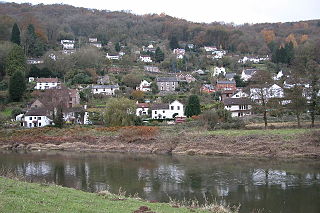
Llandogo is a small village in Monmouthshire, south Wales, between Monmouth and Chepstow in the lower reaches of the Wye Valley AONB, two miles north of Tintern. It is set on a steep hillside overlooking the River Wye and across into the Forest of Dean in Gloucestershire, England. The 2011 census population was 547.
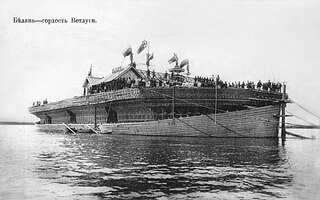
A disposable ship, also called raft ship, timber ship, or timber drogher is a ship or sea vessel that is intended for use on a single voyage. At the final destination, the vessel is broken up for sale or reuse of materials. Until the end of the 19th century, such ships were common on major rivers such as the Danube and the Rhine in Central Europe and the Mississippi in North America. There were also saltwater vessels that were primarily built for one-time sailing to break up. Some of the largest wooden ships in history were of this type.
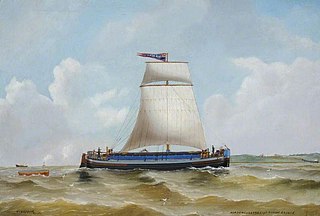
The Humber keel was a type of single-masted, square-rigged sailing craft used for inshore and inland cargo transport around Hull and the Humber Estuary, in the United Kingdom, particularly through the late 19th and early 20th centuries.

Mayflower is a steam tug built in Bristol in 1861 and now preserved by Bristol Museums Galleries & Archives. She is based in Bristol Harbour at M Shed. She is the oldest Bristol-built ship afloat, and is believed to be the oldest surviving tug in the world.

SB Centaur is a wooden Thames sailing barge, built in Harwich, Essex, England in 1895. She was used to carry various cargoes, mainly grain, for the next 60 years. During the First World War she carried food and coal to the French Channel ports. During the Second World War Centaur was damaged when sailing to assist with the Dunkirk Evacuation. She did war work for the duration of the conflict.
The rebuilding was carried out at Blists Hill Open Air Museum of the Ironbridge Gorge Museum
In about 1936 she was converted into a dumb barge and during the 1950s and 1960s she was used in the docks at Diglis basin